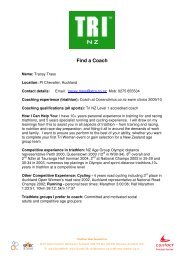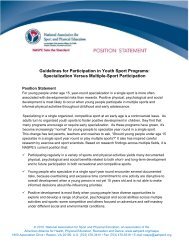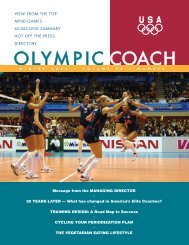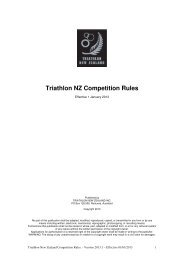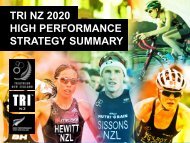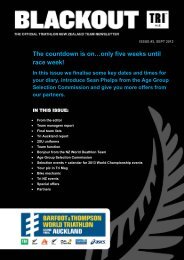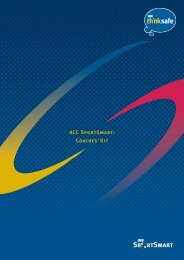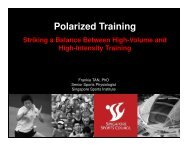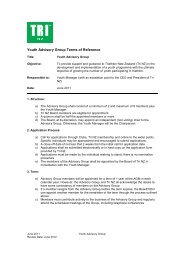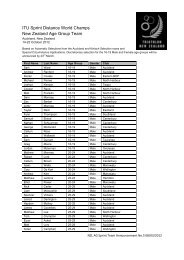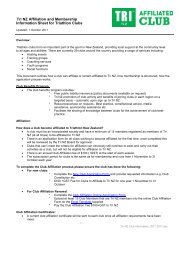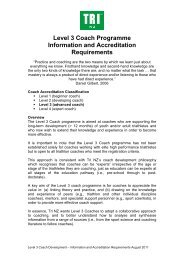The Science of Cycling - IngentaConnect
The Science of Cycling - IngentaConnect
The Science of Cycling - IngentaConnect
Create successful ePaper yourself
Turn your PDF publications into a flip-book with our unique Google optimized e-Paper software.
<strong>The</strong> <strong>Science</strong> <strong>of</strong> <strong>Cycling</strong>: Part 1 311<br />
109. Hochachka PW, Beatty CL, Burelle Y, et al. <strong>The</strong> lactate paradox 129. Lucía A, Hoyos J, Perez M, et al. Heart rate and performance<br />
in human high-altitude physiological performance. News parameters in elite cyclists: a longitudinal study. Med Sci<br />
Physiol Sci 2002; 17: 122-6 Sports Exerc 2000; 32: 1777-82<br />
110. Faria EW, Parker DL, Faria IE. <strong>The</strong> science <strong>of</strong> cycling: factors 130. Lucía A, Hoyos J, Pardo J, et al. Metabolic and neuromuscular<br />
affecting performance – part II. Sports Med 2005; 35 (4): adaptations to endurance training in pr<strong>of</strong>essional cyclists: a<br />
313-37<br />
longitudinal study. Jpn J Physiol 2000; 50: 381-8<br />
111. Edwards RHT. Biochemical bases <strong>of</strong> fatigue in exercise peradaptations<br />
131. Boulay MR, Barbeau P, Giroux M, et al. Peripheral and central<br />
formance: catastrophe theory <strong>of</strong> muscular fatigue. In: Knuttgen<br />
in cyclists during a training and competitive season<br />
HG, Vogel RD, Poortmans JR. editors. Biochemistry <strong>of</strong> exercise.<br />
[abstract]. Med Sci Sports Exerc 1992; 24: S95<br />
Champaign (IL): Human Kinetics, 1983: 3-28<br />
132. Banister EW. Modeling elite athletic performance. In: Green<br />
112. Colliander EB, Dudley GA, Tesch PA. Skeletal muscle fiber HJ, McDougal JD, Wenger HA, editors. Physiological testing<br />
type composition and performance during repeated bouts <strong>of</strong> <strong>of</strong> elite athletes. Champaign (IL): Human Kinetics, 1991:<br />
maximal, concentric contraction. Eur J Appl Physiol 1988; 58: 403-24<br />
81-6 133. Banister EW, Carter JB, Zarkadas PC. Training theory and<br />
113. Hautier CA, Arsac LM, Deghdegh K, et al. Influence <strong>of</strong> fatigue taper: validation in triathlon athletes. Eur J Appl Physiol 1999;<br />
on EMG/force ratio and cocontraction in cycling. Med Sci 79: 182-91<br />
Sports Exerc 2000; 32: 839-43<br />
134. Candau R, Busso T, Lacour JR. Effect <strong>of</strong> training on iron status<br />
114. Meeusen R, De Meirleir K. Exercise and brain neurotransmission.<br />
in cross-country skiers. Eur J Appl Physiol 1992; 64: 497-502<br />
Sports Med 1995; 20: 160-88<br />
135. Morton RH, Fitz-Clarke JR, Banister EW. Modeling human<br />
115. Davis MJ, Bailey SP. Possible mechanisms <strong>of</strong> central nervous performance in running. J Appl Physiol 1990; 69: 1171-7<br />
system fatigue during exercise. Med Sci Sports Exerc 1997; 136. Padilla S, Mujika I, Angulo F, et al. Scientific approach to the<br />
29: 45-57 1-h cycling world record. J Appl Physiol 2000; 89: 1522-7<br />
116. Davis MJ. Nutrition, neurotransmitters, and central nervous 137. Foster C, Florhaug JA, Franklin J, et al. A new approach to<br />
system fatigue. In: Maughan RJ, editor. Oxford: Blackwell monitoring exercise training. J Strength Cond Res 2001; 15:<br />
<strong>Science</strong> Ltd, 2000: 171-83 109-15<br />
117. Piacentini MF, Meeusen R, Buyse L, et al. No effect <strong>of</strong> a 138. Skinner JS, Mclellan TH. <strong>The</strong> transition from aerobic to anaernoradrenergic<br />
reuptake inhibitor on performance in trained obic metabolism. Res Q Exerc Sport 1980; 51: 234-48<br />
cyclists. Med Sci Sports Exerc 2002; 34: 1189-93<br />
139. Coen B, Schwarz L, Urhausen A, et al. Control <strong>of</strong> training in<br />
118. Hansen JJ, Faria EW, Faria IE. Effect <strong>of</strong> 5-hydroxytryptophan middle- and long-distance running by means <strong>of</strong> individual<br />
on central fatigue [abstract]. Med Sci Sports Exerc 1999; 31: anaerobic threshold. Int J Sports Med 1991; 12: 519-24<br />
S118<br />
140. Hollmann W, Rost R, Liesen H, et al. Assessment <strong>of</strong> different<br />
119. St Clair Gibson A, Schabort EJ, Noakes TD. Reduced neuro- forms <strong>of</strong> physical activity with respect to preventative and<br />
muscular activity and force generation during prolonged cy- rehabilitative cardiology. Int J Sports Med 1981; 2: 67-80<br />
cling. Am J Physiol Regul Integr Comp Physiol 2001; 281: 141. Weltman A, Seip R, Snead D, et al. Exercise training at and<br />
R187-96 above the lactate threshold in previously untrained women. Int<br />
120. Ulmer HV. Concept <strong>of</strong> an extracellular regulation <strong>of</strong> muscular J Sports Med 1992; 13: 257-63<br />
metabolic rate during heavy exercise in humans by 142. Schumacher YO, Mueller P. <strong>The</strong> 4000m team pursuit cycling<br />
psychophysiological feedback. Experientia 1996; 52: 416-20<br />
world record: theoretical and practical aspects. Med Sci Sports<br />
121. Noakes TD, Peltonen JE, Rusko HK. Evidence that a central Exerc 2002; 34: 1029-36<br />
governor regulates exercise performance during acute hypoxia 143. Hawley JA, Myburgh KH, Noakes TD, et al. Training techand<br />
hyperoxia. J Exp Biol 2001; 204: 3225-34<br />
niques to improve fatigue resistance and enhance endurance<br />
122. Lucía A, Hoyos J, Santalla A, et al. Tour de France vs Vuelta a performance. J Sports Sci 1997; 15: 325-33<br />
España: which is harder Med Sci Sports Exerc 2003; 35: 144. MacDougall JD, Hicks AL, MacDonald JR, et al. Muscle per-<br />
872-8 formance and enzymatic adaptations to sprint interval training.<br />
123. Johnson DB, Aaron EA, Babcock MA, et al. Respiratory muscle J Appl Physiol 1998; 84: 2138-42<br />
fatigue during exercise: implications for performance. Med Sci 145. Tabata I, Nishimura K, Kouzaki M, et al. Effects <strong>of</strong> moderate-<br />
Sports Exerc 1996; 28: 1129-37<br />
intensity endurance and high-intensity intermittent training on<br />
124. Coirault C, Chemla D, Lecarpentier Y. Relaxation <strong>of</strong> diaphragm anaerobic and ˙VO2max. Med Sci Sports Exerc 1997; 28:<br />
muscles. J Appl Physiol 1999; 87: 1243-52 1327-30<br />
125. Caine MP, McConnell AK. <strong>The</strong> inspiratory muscles can be 146. Stepto NK, Hawley JA, Dennis SC, et al. Effects <strong>of</strong> different<br />
trained differentially to increase strength or endurance using a interval-training programs on cycling time-trial performance.<br />
pressure threshold, inspiratory device. Eur Respir J 1998; 12: Med Sci Sports Exerc 1999; 31: 736-41<br />
58-9 147. Rodas G, Ventura JL, Cadefau JA, et al. A short training<br />
126. Williams JS, Wongsathikun J, Boon SM, et al. Inspiratory programme for the improvement <strong>of</strong> both aerobic and anaerobic<br />
muscle training fails to improve endurance capacity in athletes. metabolism. Eur J Appl Physiol 2000; 82: 480-6<br />
Med Sci Sports Exerc 2002; 34: 1194-8<br />
148. Westgarth-Taylor C, Hawley JA, Rickard S, et al. Metabolic and<br />
127. Perez HR. <strong>The</strong> effects <strong>of</strong> competitive road-racing cycling on the performance adaptations to interval training in endurancebody<br />
composition, pulmonary function, and cardiovascular trained cyclists. Eur J Appl Physiol 1997; 75: 298-304<br />
system <strong>of</strong> sport cyclists. J Sports Med 1981; 21: 165-72 149. Weston AR, Myburgh KH, Lindsay FH, et al. Skeletal muscle<br />
128. Snyder AC, Woulfe TJ, Walsh R, et al. Insensitivity <strong>of</strong> laborato- buffering capacity and endurance performance after high-inry<br />
measures to training induced improvement in athletes [ab- tensity training by well-trained cyclists. Eur J Appl Physiol<br />
stract]. Physiologist 1989; 32: 230 1997; 75: 7-13<br />
© 2005 Adis Data Information BV. All rights reserved. Sports Med 2005; 35 (4)



